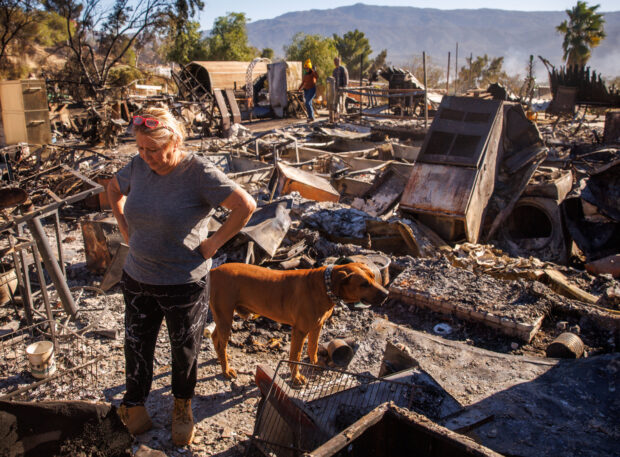California’s lofty home prices and scarce inventory already amounted to one of the most nightmarish housing markets in the U.S.. Now, challenges securing and affording home insurance in the wildfire-prone state are making it even worse.
Under the pressure of a looming closing date, prospective buyers are enduring lengthy, complex searches—and a fair amount of sticker shock–for a product that used to be something of an afterthought.
Lenders have been forced to adapt, often working closely with clients to help them land a policy so insurance doesn’t become an obstacle to approval of the loan.
“I never even talked about insurance, really up until the last year and a half,” said Julee Felsman, senior vice president of mortgage lending at Guaranteed Rate, one of the country’s largest home lenders by volume. “Now, it’s a significant impact for the borrower as they qualify for the loan.”
That’s because premiums are so high—up 55 percent across the U.S. from five years ago, according to a Guaranteed Rate report—that they eat up money in a household budget that could otherwise have gone to a mortgage payment.

Lafayette, California, is one suburb where the insurance crunch has made for a home-buyer headache.
The problem is especially acute in California, where companies from State Farm General Insurance Co. to Allstate Corp. have been reducing coverage or pulling out altogether, citing potential losses from more wildfires and state-imposed limits on rate increases.
The resulting insurance crunch has made for major headaches for buyers like Fletcher Cook, who recently relocated from Texas to the San Francisco Bay area. Immediately upon finding his dream home in the suburb of Lafayette, Cook’s real estate agent advised him to start looking for insurance.
Cook says he and his wife spoke to three dozen agents at various companies, receiving quotes he deemed exorbitant. One offered him partial coverage, in tandem with California’s FAIR plan, the state-backed insurer of last resort. But an eye-popping $35,000 deductible threw him into a state of panic.
Just before closing, he finally found a plan he could live with—but not without stress along the way. His premium is about $10,000 a year—and could be subject to a rate increase down the road.
“I either thought I was going to have to pay an arm and a leg, or I was going to lose out on this home and the mortgage,” Cook, 47, said.
Lenders Adapt
As extreme weather exacerbated by climate change has taken its toll in California and beyond, insurers continue to suffer losses from areas riddled by natural disasters. In 2023, for the fourth straight year, industry losses from catastrophic events topped $100 billion.
As it has become more difficult to get a policy, some lenders are staffing up to help buyers through the process.
Jeff Wingate, executive vice president and head of insurance at Guaranteed Rate, said he’s increased staff by more than 10% in the past year. Better Home & Finance Holding Co., another lender, has about 60 employees solely dedicated to helping clients find insurance, as compared with 10 years ago, when there was no such business in-house.
At Nation One Mortgage Corp., Phil Crescenzo Jr. says he has brought in a surveyor, insurance broker and real estate attorney for “lunch and learn” sessions to educate his loan officers and other staffers on the issue, in effort to help them navigate the complexities of the insurance turmoil. Their clients, after all, are already facing the burden of elevated borrowing costs and inflation that has yet to be fully tamed.
“With loan volume already compressed significantly, any lost closing or client denial is magnified,” said Crescenzo, a division head at the firm.
The work for lenders doesn’t stop after a purchase closes. Many are now telling homeowners to make substantial improvements after buying to avoid being dropped by their carrier. In California, that means investing in heavy mitigation efforts such as clearing vegetation around a property in a wildfire zone. In storm-battered states like Florida and Louisiana, that may require roof repairs or replacements.
“We’re just doing things differently than we ever had before,” Wingate said. “I’ve heard horror stories of customers receiving non-renewal notices because the insurance carrier said ‘your roof is too old or there’s mold, we’re not renewing unless you fix the problem.’ That’s becoming much more prevalent.”
Punishing Market
California’s housing market was already punishing enough to price out many home buyers, while the state’s high cost-of-living has driven some businesses to leave. In May, the median selling price for a home in the Golden State was $860,500, up almost 10% from the year before, according to Redfin—and nearly double the median price in the US overall.
The insurance situation only adds to the challenges. In 2024, almost 6 percent of U.S. homes, valued collectively at $3 trillion, “face severe or extreme risk of fire damage,” according to Realtor.com. About 39 percent of these wildfire-prone properties are in California and they’re worth $1.7 trillion.
More than half of California homeowners said an increase in insurance costs or coverage changes has affected them or their area in the past year, according to a Redfin survey.
And for the first-time buyers looking to join their ranks, insurance now figures as a financial obstacle.
Wingate said he is seeing fewer first-time homebuyers come in to the market “because it’s just too expensive. People are waiting until something happens going forward.”
Bare-Bones Coverage
The shrinking pool of insurers offering coverage in certain places has led homeowners to fall back on state-backed plans, which offer less coverage for higher premiums, and surplus line markets with less comprehensive policies that have fewer consumer protections, Wingate said.
Difference-in-conditions policies, which cover losses that aren’t included under a bare-bones insurance plan, are an option, but add complexity. Instead of a single plan, homeowners who use them must manage coverage across multiple policies, which are often costlier than a traditional policy.
California’s insurer of last resort has rapidly grown as more private firms have retreated. More than 370,000 homeowners—double the number five years ago—now depend on the plan for coverage. As a result, the plan faces $311 billion in potential losses, up from $50 billion six years ago, according to Victoria Roach, president of the FAIR plan.
Lenders will force-place insurance on homeowners—often at an extremely expensive rate—to cover their own risk when no other policy is available. Their biggest concerns are over the affordability challenges and potential delinquency and losses if insurance costs escalate beyond what homeowners can afford. While lenders offer some help to borrowers when a job loss occurs, there’s virtually no reprieve for those who can’t pay due to high insurance costs.
Lenders are bracing for the scenario to worsen, with resale values poised to take a hit in areas where insurance options are scarce and natural disasters are commonplace.
“That’s where you’re going to see things start to break,” said Mark Shulman, head of consumer lending at BMO Bankcorp Inc.
Top photo: A wildfire fueled by gusty Santa Ana winds destroyed homes as it ripped through rural land southeast of Los Angeles, on Oct. 31, 2023.





















 Lawsuit Alleges Girl Scouts’ Cookies Contain Heavy Metals, Pesticides
Lawsuit Alleges Girl Scouts’ Cookies Contain Heavy Metals, Pesticides  ‘Bleak’ Data: Insurance Co. Entry Level Hiring Expectations Hit Low Point
‘Bleak’ Data: Insurance Co. Entry Level Hiring Expectations Hit Low Point  New Map Shows the Rise and Fall of California’s Coast
New Map Shows the Rise and Fall of California’s Coast  Lemonade CEO Declares ‘Best Quarter Ever,’ Posts Narrowed Q4 Loss of $30M
Lemonade CEO Declares ‘Best Quarter Ever,’ Posts Narrowed Q4 Loss of $30M 